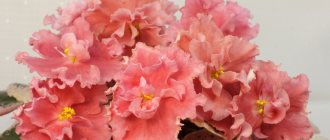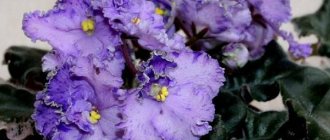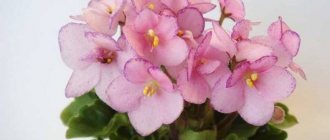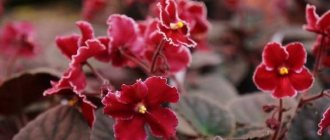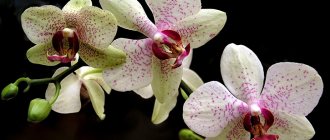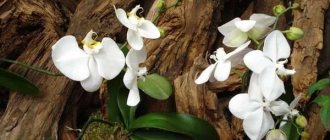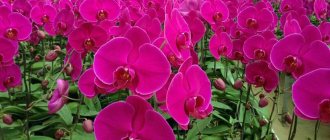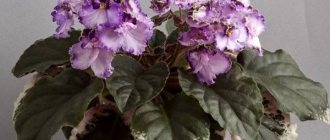Miniature-sized Saintpaulia SK-Landscape in the Fog resembles a beautiful picture, and its name conveys this feeling. Given the size of the outlet, it is extremely important to adhere to the rules of care.
If you make mistakes when maintaining miniatures, then they react more sharply, and they get sick and die more often than standard ones. Below in the article you will see a photo and description of the violet Landscape in the Fog.
What Saintpaulia Ness crinkle blue looks like
This variety of Saintpaulia stands out due to its external characteristics.
Stunning Saintpaulia Ness crinkle blue
It will be no less interesting to learn about the origin of the variety, as well as about other varieties from this group.
Description
Saintpaulia Ness crinkle blue is a semi-miniature variety. The size of the rosette, flowers and leaves is average. The plant is characterized by long flowering with breaks of 1-2 months.
The leaves are dark green, with a serrated edge and a sharp tip. The flowers are double, the petals are arranged in several layers. The color of the inflorescences is blue with a thin white rim around the edge. During flowering, the flower stalks bend under the weight of the inflorescences, lie on the rosette and almost completely cover it.
History of origin and species
Saintpaulias are also called Uzambara violets. Both names are related to the origin of the plant. The flowers were first noticed in the Uzambara Mountains region (Africa), and they were discovered by a local official, Saint-Paul Iller. He gave the seeds to one of the outstanding botanists of that time, Herman Wendland, who gave the flower the name Saintpaulia in honor of its discoverer. He also attributed the plant to the large family of Gesneriaceae.
The crinkle blue variety and many others were developed by breeder Don Nez. At first, he was engaged in crossing gloxinias as a hobby, and became interested in Saintpaulias after visiting an exhibition of Uzambara violets in Sao Paulo. The selection was so successful that the new varieties spread throughout the continent and soon gained worldwide fame.
Blooming new items in my collection: SK-Landscape in the Fog, Fairy, Buckeye Big Snowstorm, etc.
Good day, dear forum users! I continue the story about the new items in my collection. The first issue is a miniature of SK-Landscape in the Fog:
I grew it from a leaf I bought in March last year, tiny as the nail on my little finger, but very prolific. From infancy, the baby formed a neat rosette, which bloomed in mid-January, gaining barely 8 cm in diameter and many flower stalks.
All this miniature beauty has only one drawback - fallen bells, which fall out of place already on the 6th day after opening, but their abundance more than makes up for such a sad fact.
This is the first flowering, I can’t say yet how long it will last, but I’ve been admiring this amazing creation for almost a month now.
Fairy (Dadoyan) of all the numerous offspring from the leaf gave only one varietal child:
It bloomed almost a year after planting the cuttings; apparently, my conditions are not the most suitable for it, since its sisters in other houses bloomed earlier. I also had to look for a suitable place on all the shelves while the heavy 5 cm flowers opened. In addition, the plant turned out to be too sensitive to temperature changes at the beginning of winter and soon became ill, so it had to be re-rooted to save the rosette. Maybe the second flowering will be more successful.
Her athlete sister is very different in appearance: wavy leaves, cabbage flowers with a jagged edge and pink strokes on the petals, and even a green ruffle in a half-open bud:
This miracle bloomed for quite a long time - about a month, and 2 weeks after opening it began to fade, so the disease of the cellular outlet apparently had nothing to do with it, since the flowers lasted about the same amount of time:
A portrait of a varietal flower, as you can see, the color is identical, but the shape is more airy and rounded:
A leaf planted from my cell socket also produced only one cell child, this can be seen immediately from the shape of the leaves:
I received the Buckeye Big Snovstorm leaf last winter as a gift; I didn’t have a photo of the mother plant and I hadn’t seen it in collections before, so I was expecting a miracle. It turned out to be very prolific and by December began to throw out flower stalks. With wavy leaves with sparse variegation, many buds appeared from the very first flowering, but the peduncles turned out to be very short and the flowers bloomed very slowly - one every 2 weeks:
Compared to a fairly spreading rosette, flowers of 4-5 cm do not look very large. Probably, it was also affected by the fact that the outlet lives on the window next to the balcony door, so the conditions for it may be too harsh. Snow-white inflorescences (each peduncle has 4-6 flowers) with a light light green edging last a very long time, so it’s worth watching this variety, maybe the second flowering will be brighter. This variety can produce flowers with blue streaks, or completely blue: when I looked for a photo on the Internet, all the rosettes of this variety were different, so I don’t even know how cellular mine is.
Another snow-white variegated leaf, Cool Mint, was more pleasing, although it didn’t show the greenery it was supposed to have according to the variety, perhaps also because of the cold on the window. The first time I tried to grow this variety from a leaf about 4 years ago, but then I was left with the sporty version. Last year I bought this miracle for myself again, and before the new year it bloomed:
The flowers are quite large, 6-7 cm, and last for more than a month without the slightest sign of aging. With a fairly compact 25 cm socket, this is very impressive.
But even here there were some incidents: I kept putting off planting the cuttings for myself, believing that I had a baby somewhere in the stash, and the flowers were so heavy that I didn’t want to spoil the violet ahead of time, and my rosette left the exhibition for someone... then as a gift, so now I’ll order this variety for myself again, it’s too good:
I received the retro variety Cinderella's Dream in the summer as a child with the mother leaf. The girl turned out to be very flexible and had already bloomed by winter, having previously shared several cuttings with customers. The first flower, half-opened, resembled a large wooden shoe, the kind Cinderella was drawn in in books:
In winter, the sun peeks into our windows for literally minutes at a time, so at such a moment I took it off:
Portrait of a flower in full bloom. The flowers are not large, about 5 cm, fall off, but last about 10 days or even longer. This drawback does not detract from the advantages of the variety:
The rosette is perfectly round, smooth and quite compact - about 23 cm, the dark leaves always shine, setting off the delicate flowers. There are quite a lot of flower stalks and they come out constantly, so this is a long-blooming variety.
She lives on the kitchen window near the glass. For the winter, I protected the sockets with thick synthetic padding from the cold air, but on the frostiest night my girl suffered a little: the leaves became limp and signs of hypothermia appeared on them. I was already afraid that I would have to re-root it, but after standing for 3 days on a warm shelf above, the violet gained turgor again, and the draft spots on the leaves remained almost invisible. This is her before hypothermia:
And this is today, 5 days later:
I bought Buckeye Seductress as a leaf last spring, the mother rosette was so huge with such wide leaves that it seemed they would never germinate, so I took a couple of cuttings to be on the safe side. But the “burdocks” sprouted quite quickly and multiplied for almost a year, producing numerous offspring. I immediately planted my rosette in the 10th, so as not to play with the transshipment of such a horse. The variety turned out to be very flexible and began to lay a lot of flower stalks while standing on the hot top shelf in the kitchen. At the beginning of the heating season, I moved it into the room on the bottom shelf, where it bloomed safely:
The rosette stands under the “flora” and looks quite enchanting in its deceptive light:
The flowers are not very large, about 5 cm, but their number and color combined with the perfect variegated rosette are simply a miracle:
I don’t keep violets on the wick and feed them rather sparingly no more than once a month, but my young lady is already wider than 30 cm, what will happen next?
Fortunately, quite a large part of my collection consists of miniatures. I bought the delicate beauty Persian Lace in August as a big baby. After transplanting and adaptation to a new location, I had to remove all the old leaves, since the cuttings were elongated and the leaf blades were covered with spots from overexposure. By winter, the girl got used to it and picked up a lot of buds, and the rooted leaves gave birth to a bunch of babies:
There is almost no venous pattern on the flowers according to the variety, but they still captivate with their grace, and the rosette is quite acceptable in size - about 9 cm:
Not only was I captivated by the beauty, a man bought it at an exhibition in January for the woman he loved, so I didn’t even have time to photograph the rosette with a large number of flowers. The replacement is already growing up, so hopefully in the spring I will be able to photograph the girl in all her glory.
I also grew Rob's Cotton Ball from a leaf purchased in March last year, the flowers of this variety are very interesting and quite large. The rosette is even, but the heavily pubescent leaves always seem dusty, which spoils the impression a little:
Another significant drawback is that signs of aging in flowers do not appear 8-10 days after opening, although the flowers themselves last more than 3 weeks:
Maybe in more favorable conditions this variety will behave differently, but for me it does not shine, although I would like to:
But the charming greenflower Mac's Momentary Meltdown turned out to be completely problem-free and won me over from the very first flower:
I bought her as a baby in October last year, and already before the New Year she began to throw out flower stalks. The flowers are simply huge compared to the 8 cm rosette:
This variety in many collections comes with blue streaks or even blue, so you don’t even know which option is correct, maybe someone can tell you. But I really like my plant, especially since I read that its flowers last a record long time, gradually adding to the bouquet.
These are such touching “faces”:
That's all for now, thanks for your attention.
Features and characteristics of Ness varieties
Violet Humako inches - plant features
As a result of many years of work, Don Ness gave the world many varieties of Saintpaulia. Some of them deserve special attention. For example, such as Uzambara violet Ness orange pekoe or antique red.
Crinkle Blue
It is distinguished by almost continuous flowering. Double flowers resemble miniature blue roses. Violet is very unpretentious and easy to grow.
Crinkle blue
Orange Pekoe
Usambara violet Ness Orange Pekoe has double or semi-double flowers in a deep coral shade.
Orange Pekoe
The inflorescences look very decorative against the background of creamy-green and sometimes green-pink leaves.
Satin Rose
Double flowers with a delicate white-lilac color that changes from the middle to the edge.
Satin Rose
The peculiarity of the variety is the coronal arrangement of inflorescences. The leaves have pronounced ribbing and a serrated edge.
Spring Blush
Single and semi-double flowers consist of white petals with soft pink stripes and purple spots.
Spring Blush
Saintpaulia breeders call this color a chimera. The plant is very easy to care for and has long and abundant flowering.
Blueberry Puff
The blue flowers of this variety seem to be decorated with white specks of paint. Outwardly, it looks like the glare of sunbeams on the petals. The inflorescences are dense, up to 15 flowers can be collected on one.
Blueberry Puff
Tiny Flame
Delicate purple double or semi-double flowers contrast against the background of dark foliage.
Tiny Flame
The peculiarity of the variety is a creamy white border along the edge of the leaves.
Pink Confetti
This compact variety of Saintpaulias has original flower colors.
Pink Confetti
The white petals around the edges seem to be covered with splashes of fuchsia paint.
Red Velvet
The flowers are simple, with wavy edges of the petals.
Red Velvet
The velvety scarlet color becomes slightly lighter from the middle to the edge. Violet is easy to care for and simply reproduces.
Angel Face
The flowers are shaped like miniature bells.
Angel Face
Petals with a slight waviness along the edge have a fuchsia tint.
Antique Red
Against the background of dark green foliage, double flowers of rich red color, similar in shape to miniature roses, stand out brightly. Violet blooms almost all year round.
Antique Red
Up to 7 flowers bloom simultaneously on one peduncle.
Fantasy Gold
The color of double flowers simultaneously contains yellow, pink and fuchsia shades.
Fantasy Gold
On each petal they are combined randomly. The leaves are deep green, almost black.
Blueberry Kiss
The variety is distinguished by large flowers of original color.
Blueberry Kiss
The snow-white center turns into the blue edges of the petals. Violet blooms for more than 6 months. The inflorescences form very large.
Reviews about violet
Review 1 The socket is very loose. Based on my experience, I will say that the stepson is very careful. I now have four heads on Peyzazhik, I can’t cut them off because two seed pods are ripening, I’m afraid of harming them. As soon as I remove the seeds, I’ll immediately deal with the heads.
The violet in question attracts with its miniature shape.
Review 2 Very delicate and beautiful violet. Sometimes it blooms in different colors for me. On one bush there may be several white ones with a blue coating and several lilac ones. This composition looks very cool, as if two varieties are growing together.
Review 3 The bush is good, grows and blooms quickly. I had it on the wick as is, and it feels very good. Only the size is slightly different - on the wick I have a rosette of 9-10 cm, and on watering under the leaves 7-8, maximum 9.
Features of care
Saintpaulias are unpretentious indoor flowers. To admire the beautiful blooms almost all year round, it is enough to follow a few rules regarding care and maintenance:
- Watering is carried out in the pan. To do this, use settled water at room temperature.
- The temperature is maintained at 20-23 °C, the main thing is not lower than 18 °C.
- Lighting is necessary for a long time and intense, but not direct sunlight.
- It is better to purchase ready-made soil, especially for Saintpaulias.
- Mineral fertilizing is applied in the spring and summer, once every 10-14 days.
Violet VaT Tsar Peas - plant features
Caring for Saintpaulias is quite simple. The main thing is to prevent the soil from becoming waterlogged and to provide the plants with good lighting.
Attention! Spraying and wiping leaves is strictly prohibited. To maintain humidity, it is recommended to place the pot on a tray with damp pebbles or expanded clay.
Reproduction
What is the name of violet pink, blue, purple and others
Most often, Saintpaulias are propagated by leaf cuttings. Only healthy and not too young leaves should be used.
Procedure:
- The cuttings are placed in water until roots appear.
- Then it must be rooted in a substrate of peat and sand mixed in a 2/1 ratio.
- After 2-3 leaves appear, they are picked into separate pots.
Propagation by leaf cuttings - quick and easy
For large plants, when replanting, the method of dividing the bush is used. Propagation by seeds is a rather labor-intensive and time-consuming process, which is only relevant for obtaining plants of a rare variety.
Attention! To get seeds yourself, you need to carry out artificial pollination of flowers.
How does a flower reproduce?
Like many other violets, Sunny Boy reproduces in several ways:
- leaves (this is the most convenient way);
- the plant takes root well with cuttings and flower stalks;
- from seeds (the most difficult method).
The most popular propagation of violets is by rooting leaves. To do this, it is enough to take one leaf from the parent bush, cut at an angle. It is immersed in water for a while until small roots appear.
As a rule, this happens within a couple of weeks. When the root reaches a size of 5 mm, you can plant the violet in a pot. It is advisable to cover the plant with film until the first young leaves appear. With proper care, you can expect the first flowers within a year.
When and how does it bloom
Saintpaulia or violet, Ness crinkle blue has a very long flowering period. Almost all year round the rosette is covered with lush double inflorescences.
During the flowering period, the plant must be properly cared for. Fertilizing should be done at least once every 10 days. It is necessary to prevent temperature changes and protect the flower from drafts.
Important! Under no circumstances should you move a blooming Saintpaulia to another place. During this period the plant is very sensitive.
Possible problems during cultivation
The reasons for the deterioration in the appearance of Saintpaulia can be improper care, attack by pests or diseases.
Improper care
Errors in care include excessive watering, non-compliance with light and temperature conditions. Signs that the plant is experiencing discomfort include the appearance of spots on the leaves or their wilting.
Pests and diseases
Usambara violet Ness Crinkle Blue is susceptible to a number of diseases, such as late blight, fusarium, powdery mildew and various rots. The most common parasites of the plant are aphids and cyclamen mites. At the first signs of damage to the flower, the leaves and soil should be treated, and sometimes transplanted into another pot.
Saintpaulias - flowering and unpretentious plants
Saintpaulia Ness crinkle blue is a beautiful variety presented to the world by breeder Don Ness. His name is also given to such species as Uzambara violet orange pekoe, satin rose and many others. If you follow simple rules for care and maintenance, these unpretentious flowers will delight you with beautiful blooms almost all year round.
